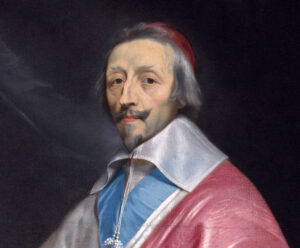In France during the early 1600s there lived a man named Cardinal Richelieu. This man was a clergyman, a nobleman and a statesman. In 1614, he entered politics in France, a common practice for members of the clergy. He was smart and ambitious, and quickly rose through the ranks of both the Church and the Government. During this day and age, the divide between Church and state was virtually non-existent, and many major statesmen either belonged to the clergy, or had close ties to them.
In 1616, Cardinal Richelieu was appointed as Secretary of State and was given the responsibility of dealing with French foreign affairs. At the time, there were no more than 100 French permanent residents in the New World, and the Cardinal saw an opportunity to expand the boundaries of both his religion and the empire. In 1627, as a part of his program to develop external trade for France, he created the Company of 100 Associates and the company was officially established by an edict of King Louis X111 in May of 1628. This new association was formed with a large sum of starting capital, and was divided into 100 shares. Members of this company included the Cardinal himself, officials, merchants, as well as the now-famous Samuel de Champlain. Management of this company was entrusted to 12 directors. Their mandate was to colonize the New World, and their first step was to agree to transport 4,000 colonists to Canada before 1953. They also agreed to support the colonists during their first three years colonizing. Due to the highly religious nature of both the Company and its members, only native French Catholics were to be sent, and priests and nuns were to be maintained at all French settlements. In return, the Company was given a monopoly of the whole country of New France, all the way from Florida in the south, to the Arctic circle in the north. It was granted the authority to distribute lands, and was given a complete monopoly of the fur trade, a monopoly of 15 years for all other trade with the exception of cod and whale fishing, which was to be available to all French subjects.
Unlike many of their contemporaries, the French had maintained good relations with the Natives in the New World. They saw these people as means to quickly increase their ranks, thereby solidifying their control of the country. The Natives were expected to convert to Christianity, and Jesuits were an integral part of the mission. Any Natives who converted were considered Frenchman and were encouraged to integrate with the French colonists. Their method of conversion, not requiring the Native people to give up their entire culture or belief system, was an easy sell for the Natives, and many converted, benefitting from the new rights afforded to them as Frenchman and from the assistance of the ever-present Jesuit priests and Nuns.
One of the most well-known employees of the Company of 100 Associates was Samuel de Champlain. His journeys through Canada also brought the first mention of another major player in our story, Olivier LeTardif. LeTardif was in Quebec from about 1621 onward. He was an assistant clerk for the Company of 100, and Samuel du Champlain’s most trusted personal interpreter. He was a collaborator in the missionary effort as well, supporting the Jesuits and acting as a godfather to the Indians. He even administered baptisms, and as we will discuss later, adopted Indian children.
Olivier LeTardif spent much time travelling deep into the Canadian wilderness working to make contact with the many outlying Indian settlements in what was known as the “bad country”. At his side during these journeys was his friend and faithful companion Roch Manitoubeouich. Roch was a Huron man who was converted to Christianity by French missionaries. His Christian name, Roch, was in honor of St. Roch, the patron saint of cattle and dogs, and those who love them.
The two men travelled for many years as representatives of the company, Roch as interpreter and Olivier as company man. One can only imagine the types of dangers and adventures they had in their travels, and the people they met and interacted with. Their travels were highly successful, and eventually, Olivier LeTardif was given a promotion to Head Clerk of the Company of 100 Associates, forcing him to settle down into a more sedentary life in a more administrative position. Roch also settled down, going to join his people at the Aboriginal settlement at Sillery near Quebec.
It is in Sillery that Roch meets Outchibahanoukoueou (often referred to as Oueou). Oueou was a young Abenaki woman. Many of the Abenaki people who had lived along the Becancour River had made their way into Quebec as their territory and resources were destroyed by encroaching settlements, and they were further pushed out by the warring Iroquois. Oueou is an ancestor claimed by many Abenaki people, and was born along the Becancour River around 1602-1606. It is believed by many that the couple married at Sillery, but there is no official record of their marriage. Roch and Oueou carried on their lives until the arrival of their first child, Marie Sylvestre Olivier. Unbeknownst to them at the time, this very special little girl would come to hold a unique place in Canadian history, and be an important fountainhead to many Métis families from this region.
Her life was quite well documented, and in our next blog post, we will discuss Marie, her life, and why she is such an important part of not only Métis history, but the history of Canada.
Sources:
https://en.wikipedia.org/wiki/Cardinal_Richelieu
https://www.wikitree.com/wiki/Manitouabeouich-9
http://www.cowasuck.org/aln8bak/2010/issue_03/10_03.pdf
http://www.liquisearch.com/company_of_one_hundred_associates/company_history
http://www.findagrave.com/cgi-bin/fg.cgi?page=gr&GRid=9562398
http://www.upperstjohn.com/nellie/d706.htm
http://ericpouliotarchives.webs.com/part4unions16001800.htm
http://www.genealogy.com/forum/surnames/topics/tardiff/282//


